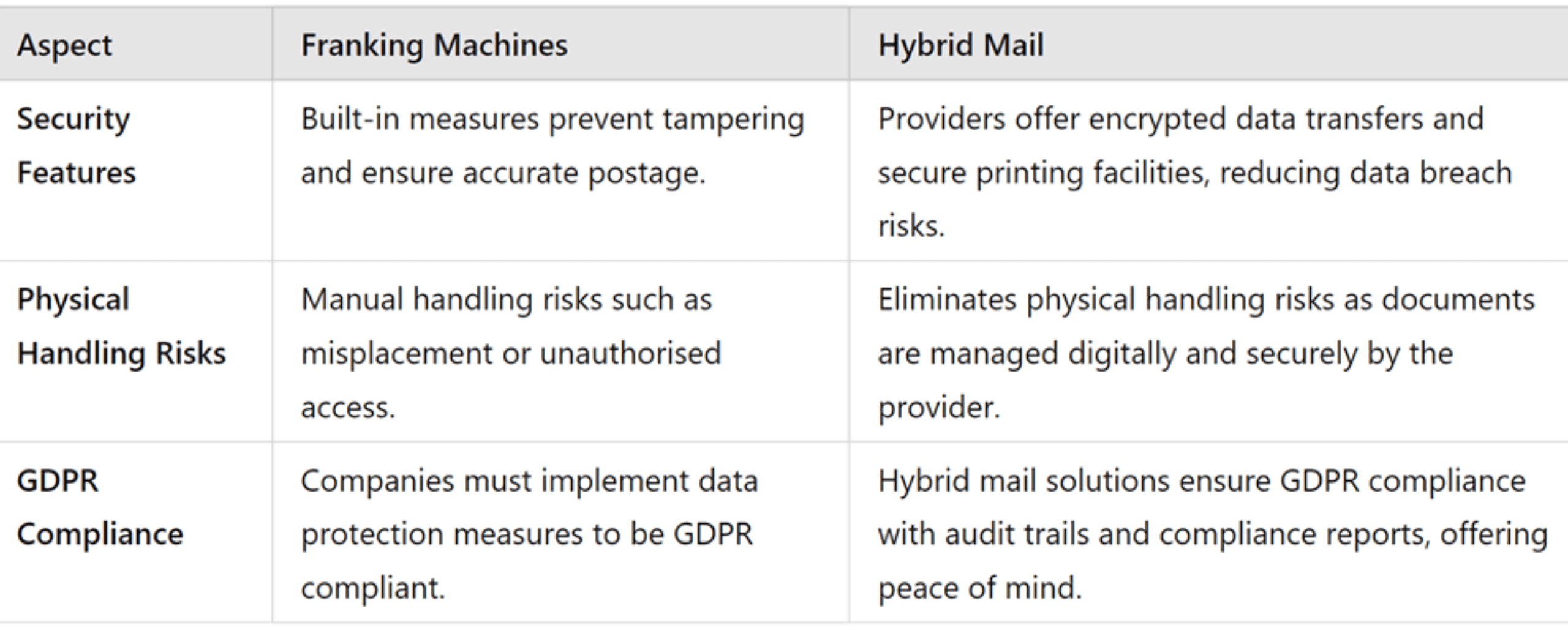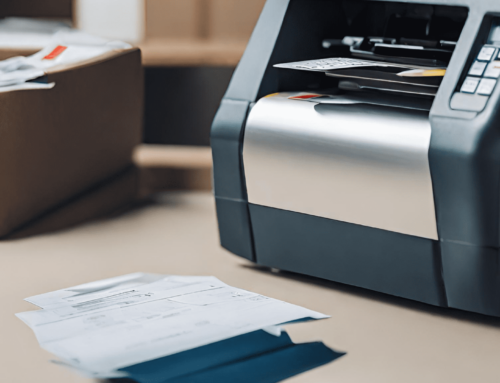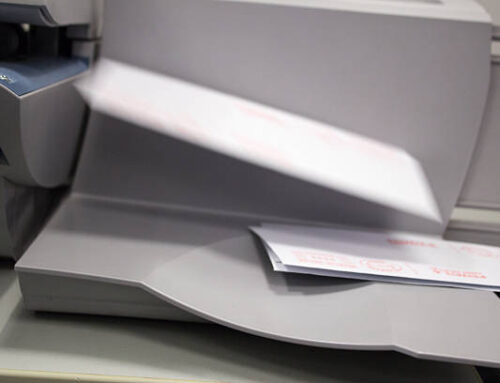Imagine dramatically reducing your mailing costs while boosting efficiency with just one decision. Intrigued? The right mailing solution could be the breakthrough your business needs.
Every business faces the challenge of managing mailing costs and efficiency. As such, the debate between traditional franking machines and innovative hybrid mail solutions is more relevant than ever. While franking machines have been a staple for many, hybrid mail is emerging as a powerful contender, offering digital advantages.
imail comms, a leader in innovative mailing services, is at the forefront of this evolution, providing expertise in both franking and hybrid mail systems. Our commitment to improving business communications and our insight in both worlds will help you determine which method best suits your needs.
Ready to uncover the details? Let’s dive in!
Table of Contents
- Understanding Franking Machines
- The Basics of Hybrid Mail
- Cost Considerations
- Efficiency and Time Savings
- Security and Compliance
- Operational Efficiencies
- Flexibility and Scalability
- Environmental Impact
- Choosing the Right Solution
- A Final Thought
- Frequently Asked Questions
Understanding Franking Machines
Franking machines have long been a cornerstone of business mail. These devices automate the process of applying postage to envelopes and letters, offering a straightforward solution for managing mailing costs. By printing postage directly onto envelopes, letters or labels, franking machines eliminate the need for traditional stamps, making the process more efficient.
How They Work
Businesses lease or purchase a franking machine, which connects to the Royal Mail’s system to download the latest postage rates. Users can weigh their mail, select the appropriate postage, and print it directly onto the item.
This system simplifies bulk mail, especially for enterprises handling large volumes of outgoing mail. Furthermore, franking machines can print letters with company logos and promotional messages, adding a professional touch to correspondence letters. Many businesses use a pre-printed letterhead to further enhance the professional look of their mail.

The Basics of Hybrid Mail
Hybrid mail is a modern solution that integrates digital technology with traditional mail processes. It allows businesses to send physical mail without the need for in-house printing and mailing equipment. By simply uploading documents digitally, hybrid mail providers handle the printing, sorting, and delivery.
How It Works
Users create their documents using standard desktop office software and upload them to a secure mail portal. The provider then prints, packages, and sends the documents via traditional mail services, such as the Royal Mail. This hybrid mail work process ensures efficiency and security.
Cost Considerations
Understanding the costs associated with both systems is essential for customers in making an informed decision. Here’s a detailed comparison under key points.
Initial Investment
Franking Machine
- Requires an upfront cost to purchase or lease the machine. Basic models can start around £100, while advanced units may reach several thousand pounds.
- The initial investment includes the price of the machine and possibly additional software or hardware for integration.
Hybrid Mail
- No initial equipment fees are involved. You only need to set up an account with the hybrid mail provider.
- The start-up process is generally quick and involves minimal financial outlay.
Operational Costs
Franking Machine
- Ongoing expenses include ink cartridges, labels, and regular maintenance. Ink cartridges can cost between £30 and £60 each, and labels around £20 per pack.
- Staff time required for managing the machine and processing direct mail adds to operational charges.
- Despite these expenses, discounted postage rates for franked mail can lead to substantial cost saving benefits over time.
Hybrid Mail
- Operates on a pay-as-you-go model, charging per piece of mail sent. Prices typically range from 45p to 60p per item, including printing and postage.
- Bulk discounts are often available, further reducing costs.
- Eliminates the need for purchasing and maintaining direct mail equipment, saving on operational expenses.
Total Cost of Ownership
Franking Machine
- While initial and operational value can be high, the savings from discounted postage rates can offset these expenses over time.
- Hidden fees such as staff time and maintenance must also be considered.
Hybrid Mail
- Offers a more predictable pricing structure with a pay-as-you-go model.
- The absence of equipment costs and maintenance expenses makes it a cost-effective option for many.
- Time savings from automation and outsourcing can also contribute your annual saving potential.
Cost Comparison Based on 2024 Royal Mail Prices
According to the 2024 Royal Mail pricing as of 4th June 2024:
- Franked Mail: The cost for a standard first-class letter is approximately 73p, while second-class is around 54p. Discounts for volume mailings can reduce these rates further.
- Hybrid Mail: Prices vary based on provider and volume but generally include a fee per piece of mail from 69p, including printing and postage.
These comparisons highlight that while a franking machine offers discounted rates, hybrid direct mail can be cheaper and is able to provide more comprehensive savings on postage costs.
Efficiency and Time Savings
Ever felt like your team spends too much time managing direct mail? Let’s look at how both these post systems can make a difference.
Franking Machine
- Manual Input: Staff must weigh mail, select postage rates, and print postage, consuming valuable time.
- Routine Maintenance: Regular upkeep, including ink and label replenishment, adds to the workload.
- Operational Workflow: Handling large volumes of direct mail can be labor-intensive, causing potential delays during busy periods.
Hybrid Mail
- Automation: Simply upload documents digitally, eliminating in-house printing, folding, and stamping.
- Outsourcing: Providers manage printing, sorting, and delivery, drastically reducing staff workload.
- Streamlined Operations: Faster processing and delivery times, especially for bulk mailings, enhancing overall efficiency.
Security and Compliance
Imagine your customer’s data and money falling into the wrong hands; frightening, right? Ensuring data security is a top priority for any business. Here’s how franking machines and hybrid mail solutions safeguard your information.
Franking Machine
- Security Features: Built-in measures prevent tampering and ensure accurate postage.
- Physical Handling Risks: Manual handling risks such as misplacement or unauthorized access.
- GDPR Compliance: Companies must implement data protection measures to be GDPR compliant.
Hybrid Mail
- Enhanced Security: Providers offer encrypted data transfers and secure printing facilities, reducing data breach risks.
- GDPR Compliance: Hybrid mail solution ensures customer data protection throughout the process, with audit trails and compliance reports, offering peace of mind.

Operational Efficiencies
Enhancing operational efficiency is critical for managing business mail effectively. Let’s dive into the details of how the two methods compare.
Manual Operations
Franking Machine
- Staff must handle every step, from weighing, franking, sorting, and sending each piece of direct mail.
- This process is time-consuming and requires significant manual labour.
- Each mail piece needs individual attention, which can slow down overall productivity.
Hybrid Mail
- Fully automates the mailing process. Businesses upload documents digitally, which are then printed, folded, and mailed by the provider.
- Eliminates the need for in-house handling, significantly reducing manual labour.
- Streamlines operations by managing bulk mailings efficiently, freeing up staff to focus on other tasks.
Maintenance Requirements
Franking Machine
- Regular maintenance is required to keep the machine operational, including refilling ink and replacing labels.
- Maintenance tasks add to the operational burden, requiring additional time and resources.
- Downtime due to maintenance can disrupt schedules.
Hybrid Mail
- Maintenance and operational tasks are handled by the provider.
- Avoids the need for regular upkeep and the associated fees.
- Ensures consistent, uninterrupted service without the hassle of machine maintenance.
Peak Period Efficiency
Franking Machine
- Handling large volumes of direct mail can cause delays, particularly during busy periods such as end-of-month billing cycles or seasonal promotions.
- Increased volume can lead to bottlenecks, impacting overall efficiency.
- Staff may need to work overtime to manage peak loads, increasing labour charges.
Hybrid Mail
- Easily scales to accommodate varying mail volumes, ensuring smooth operations even during peak times.
- Providers have the infrastructure to manage bulk mailings efficiently, without the need for additional internal resources.
- Consistently high performance during peak periods supports continuous operational efficiency and adaptability.
Flexibility and Scalability
Mailing needs can change rapidly, and having a flexible and scalable solution is crucial. Here’s how franking machines and hybrid mail solutions stack up in terms of adaptability:
Franking Machine
- Flexibility: These machines offer a certain level of flexibility, allowing companies to handle a variety of direct mail types and sizes. Companies can print logos and marketing messages on envelopes, adding a personalised for their clients.
- Scalability: While this machine can handle increased volumes of mail, scaling up requires additional machines and staff, which can lead to higher fees and logistical challenges. During peak periods, the capacity of existing machines might not be sufficient, potentially causing delays.
Hybrid Mail
- Flexibility: Highly flexible and accommodates different types of documents and mailing requirements. Businesses can easily adapt their processes without the need for physical changes in equipment or space.
- Scalability: A Hybrid mail solution is designed to scale effortlessly. Providers can manage varying volumes of mail, from small batches to large campaigns, without requiring additional resources from the business. This scalability ensures consistent performance even during peak periods, maintaining efficiency and reliability.
Overall Adaptability
Franking Machine: Limited by physical equipment and manual processes, making rapid scaling challenging and potentially costly.
Hybrid Mail: Highly adaptable, with the ability to quickly adjust to changing needs and volumes without additional investments in equipment or staff.
Environmental Impact
With increasing focus on sustainability, the environmental impact of these solutions is a key consideration. Let’s compare how the two methods fare in terms of environmental responsibility.
Franking Machine
Resource Consumption: They require physical resources such as ink cartridges, labels, and paper. The production and disposal of these materials contribute to environmental waste.
Energy Use: Operating these machines consumes energy, adding to the carbon footprint. Regular maintenance and machine usage increase overall energy consumption.
Waste Generation: Ink cartridges and labels create waste, which needs proper disposal. Additionally, misprints or mistakes can lead to wasted materials.
Hybrid Mail Solution
Reduced Resource Use: Significantly reduces the need for physical resources, and office space, as managing documents digitally reduces reliance on paper, ink, and labels.
Energy Efficiency: Providers optimise their printing equipment and processes to be energy-efficient. Centralised print facilities often have advanced, energy-saving print technologies that reduce overall consumption.
Lower Waste: Digital document handling reduces errors and waste. Misprints are less frequent, and there’s no need for disposal of used cartridges or excess labels.
Choosing the Right Solution
Selecting the optimal mailing solution for your business hinges on several key considerations. First, assess the size of your business and the volume of mail you handle. A smaller business with consistent, low-volume needs might find franking machines adequate, offering a straightforward way to manage post fees. However, the manual effort and maintenance required can be a drawback during peak times.
For businesses with larger or fluctuating mailing volumes, a hybrid mail system stands out as a highly scalable and efficient solution. By automating the entire process, hybrid mail reduces manual labour and operational costs, making it ideal for companies looking to streamline their operations and save time and money.
Consider the total cost of ownership, including initial investments and ongoing expenses. While franking machines involve upfront fees for equipment and continuous costs for supplies and maintenance, a hybrid mail system operates on a pay-as-you-go model with no need for physical equipment. This can lead to significant cost savings, with benefits particularly for businesses with high mailing volumes.
By evaluating the factors discussed throughout this article, you can choose a marketing and mailing solution that best fits your business vision, ensuring efficiency, cost-effectiveness, and compliance with local government.
A Final Thought
Choosing between franking machines and hybrid mail is a pivotal decision that can shape your business’s efficiency and cost management. Imagine freeing your team from the tedious task of manual mail handling or drastically save money and time by cutting down your mailing costs; these are the tangible benefits at stake.
For many small businesses, with steady, predictable needs, franking machines offer a reliable solution. But if you’re aiming for a future where automation reigns supreme, hybrid mail stands out as the clear winner. It not only streamlines your operations but also scales effortlessly with your growing needs.
imail comms is your trusted partner in navigating this choice. Whether you stick with the tried-and-true or leap into the digital age with hybrid mail, we’re here to ensure your mailing process is seamless, secure, and sustainable. Whatever choice you make, rest assured that we have a pricing plan that suits your needs.
Ready to transform the way you handle mail? The choice is yours, and we’re here to help you make it!
Frequently Asked Questions (FAQs)
Below are some common queries about franking machines and hybrid mail services:
What is a print driver?
Hybrid mail often includes a print driver that integrates with your desktop applications. This helps you save time and money and facilitates the entre post process.
Can I use document templates with hybrid mail?
Yes, you can create and save document templates to make your communications smoother and more time-efficient.
How can I calculate savings with hybrid mail?
You can use a hybrid mail savings calculator to estimate potential savings. This tool helps you compare current mailing costs with the potential savings this system offers, giving you a clear financial picture.











Leave A Comment
You must be logged in to post a comment.